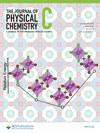掺杂含金属簇和氯化物的碳纳米管网络
IF 3.3
3区 化学
Q2 CHEMISTRY, PHYSICAL
引用次数: 0
摘要
掺杂碳纳米管薄膜可以提高其导电性和化学稳定性。一种传统的掺杂方法是原位还原 AuCl3,然而一旦薄膜经过热退火处理,它对导电性的有利影响就会减弱。密度泛函理论和半经典玻尔兹曼输运理论计算表明,随着 Aun 簇(n ≤ 10)的增大或 Cl 杂质浓度的降低,掺杂的 (8,0) 碳纳米管网络的导电性会降低。在最小和最大的簇尺寸之间,金属网络中沿着纳米管和穿过交界处的电导率分别下降了 47% 和 90%。半导体网络的下降幅度分别为 50% 和 13%。含有 Au5 簇的网络(比原始网络大 193 倍)在连接处的导电率最高。此外,去除 Cl 杂质后,电传输也会降低。与不含杂质的网络相比,含有过量 Cl 杂质的网络沿纳米管和穿过交界处的导电率分别大 9.6 倍和 36.7 倍。控制簇大小和 Cl 含量可减轻碳纳米管薄膜在热退火后的掺杂。本文章由计算机程序翻译,如有差异,请以英文原文为准。
Dedoping of Carbon Nanotube Networks Containing Metallic Clusters and Chloride
Doping carbon nanotube films improves their electrical conductivity and chemical stability. One conventional doping method is the in situ reduction of AuCl3 and yet its beneficial properties on the electrical conductivity lessen once the films are thermally annealed. Here, density functional theory and semiclassical Boltzmann transport theory calculations show a deterioration of the electrical conductivity of a doped network of (8,0) carbon nanotubes as the Aun clusters (n ≤ 10) become larger or the Cl impurity concentration decreases. Between the smallest and largest cluster sizes, the conductivity along the nanotubes and across the junction dropped by 47 and 90% in metallic networks. The declines in semiconducting networks were 50 and 13%, respectively. The maximum electrical conductivity across the junction was for networks containing Au5 clusters (193 times larger than the pristine network). Additionally, the electrical transport was reduced when Cl impurities were removed. Networks with excess Cl impurities had 9.6 and 36.7 times larger electrical conductivity along the nanotubes and across the junction than networks without impurities. Controlling the cluster size and Cl content would mitigate the dedoping of carbon nanotube films after thermal annealing.
求助全文
通过发布文献求助,成功后即可免费获取论文全文。
去求助
来源期刊

The Journal of Physical Chemistry C
化学-材料科学:综合
CiteScore
6.50
自引率
8.10%
发文量
2047
审稿时长
1.8 months
期刊介绍:
The Journal of Physical Chemistry A/B/C is devoted to reporting new and original experimental and theoretical basic research of interest to physical chemists, biophysical chemists, and chemical physicists.
 求助内容:
求助内容: 应助结果提醒方式:
应助结果提醒方式:


